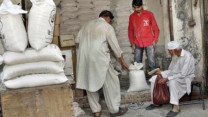Why is the retail sector in Pakistan booming?
More women are entering the workforce, raising household incomes and allowing more consumer spending.

Why is the retail sector in Pakistan booming?
It is the paradox that puzzles everybody: the headline numbers indicate an economy in an abysmal state, but everywhere one looks, there are people shopping like there is no tomorrow. How is this possible? An analysis conducted by The Express Tribune reveals a surprising answer: women.
While the headline GDP numbers suggest sluggish economic growth, not all sectors are underperforming. A closer look suggests that the economic slowdown has been far from uniform, with some sectors booming, while others are in a deep slump. The retail and wholesale sector in Pakistan was worth about $40 billion in fiscal year 2012, and has been growing at 5.3% in real (inflation-adjusted) terms for the past five years, much faster than overall economic growth during that period.
And the benefits of this growth have been visible throughout the country. While large shopping malls opening up has become common place in cities like Lahore and Karachi, national newspapers now carry advertisements for shopping malls in smaller cities like Dera Ghazi Khan, Sukkur, Sargodha, etc as well. The average Pakistani household is very clearly more able and more willing to shop than ever before.
The reasons for this newfound consumerism are complex. Despite all the complaints about inflation, household incomes for Pakistanis in urban areas rose faster than inflation by an average of about 1.5% per year between 2006 and 2011, a period of extraordinarily high inflation rates. (Rural Pakistan did not fair quite as well.) The average household size also fell during that period, further raising per capita gains.
But the real change appears to have taken place at the top quintile of urban Pakistani households: these households went from negative savings to savings that now equal approximately 14% of their incomes. This allows them considerable leeway in spending, which has resulted in a large, sustained, and very visible boom in retail and consumer goods over the past five years.
Food and consumer goods companies listed on the Karachi Stock Exchange have seen their revenues rise by over 20% per year between 2005 and 2010, the latest year for which aggregate figures are available. This figure is much faster than the 15.2% average revenue growth experienced by listed companies overall during that period.
Why household incomes have risen in this manner is not a subject that has been explored in much depth by economists or analysts. Yet a closer look at the labour force statistics reveals a rather interesting trend: the percentage of women who participate in the formal labour force has gone up from 16.3% in fiscal year 2000 to just over 24.4% in 2011.
Women, especially in urban areas, are increasingly contributing to their household income by taking on employment or starting home-based businesses where they are paid per unit of output.
This increasing economic contribution of women to the average Pakistani household has also led to an increase in the variety of products marketed to women. A decade ago, feminine hygiene products would hardly ever advertise. Now there are massive billboards advertising them in cities across the country. The lawn boom attracts headlines for its high-end designers selling to wealthy women, but the real money spinner in the lawn business is the medium to low-priced product being sold to the average middle class woman working in a white-collar service sector position who needs affordable clothing to wear to work.
Even banks have begun targeting women: Bank AL Habib advertises its savings account products to women through television and print publications.
The reasons for why women have entered the workforce are manifold. Education levels have been rising rapidly across the board. Fertility rates have dropped from 7.1 in 1980 to just over 3.1 in 2011, causing household sizes to decline. Women with fewer children have more freedom to pursue careers outside the home.
And persistently high inflation may also have forced many families to consider being more open to women working outside the house: a second income can clearly go a long way in changing the fortunes of a household. It has clearly already helped the economy through a particularly difficult time.
Published in The Express Tribune, July 11th, 2012.



















COMMENTS
Comments are moderated and generally will be posted if they are on-topic and not abusive.
For more information, please see our Comments FAQ